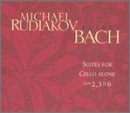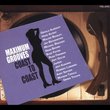| All Artists: J.S. Bach, solo cello MIchael Rudiakov Title: Bach Suites for Cello Alone Members Wishing: 0 Total Copies: 0 Label: Eroica Classical Original Release Date: 1/12/2002 Re-Release Date: 7/7/2002 Genre: Classical Styles: Chamber Music, Historical Periods, Classical (c.1770-1830) Number of Discs: 1 SwapaCD Credits: 1 UPC: 714548307926 |
Search - J.S. Bach, solo cello MIchael Rudiakov :: Bach Suites for Cello Alone
 | J.S. Bach, solo cello MIchael Rudiakov Bach Suites for Cello Alone Genre: Classical
Bach wrote six Suites for cello alone and six Partitas for violin alone. They were written in 1720; he was 35 years old. The most remarkable fact about these masterpieces is that they were written at all. In 1720, Bach was... more » |
Larger Image |
CD Details
Synopsis
Album Description
Bach wrote six Suites for cello alone and six Partitas for violin alone. They were written in 1720; he was 35 years old. The most remarkable fact about these masterpieces is that they were written at all. In 1720, Bach was employed at the provincial court at Koethen, Saxony. His duties there were to provide music for specific occasions. Sunday services, weddings, and special events at court required his services as organist and composer, but there is no apparent reason for the writing of substantial works for cello or violin alone. There were no cello or violin masters in Bach's immediate vicinity. So, for whom were these works written and who played them? We don't know. One can only assume that Bach was flexing his compositional muscles in this labor of love. It is a lucky thing for us that he did. He was the first composer of stature to write for cello alone. In that, he was generations ahead of his time. Not until the 20th century do we find music comparable to! Bach's for the solo cello. The Suite was a popular form in Bach's day. It came from France, as the French movement titles suggest, and was embraced by German composers as a neat way to compose dance-like music for public use. There are usually 6 movements in every Suite. The Prelude is the curtain-raiser and foreshadows the atmosphere of the work, the Allemande is more or less stately, the Courante is on the quick side, the Sarabande, very slow and introspective, the Bourées (or Gavottes) lighthearted, and the final Gigue is a romp. This is a very general description. The particulars vary from Suite to Suite. For me, the following describes the Suites: No. 3 in C Major - majestic, very positive. No. 2 in D Minor - introspective, delicate and the shortest of the three. No. 6 - a very different story. It was written for either the five-stringed Violoncello Piccolo or Viola Pomposo which was held under the chin and had a very short career. But, the instrument inspired Bach to write this masterpiece. No. ! 6 is in turn a sunny, rhapsodic, deeply philosophical work of large and generous proportions. It has a soprano quality because the cello uses a great deal of its uppermost registers. It is interesting to note that Bach has no dynamic markings in any of the Suites, except for No. 6, and here only in the first few measures of the Prelude. Bach trusted his performers to come up with the right interpretation. J.S. Bach ( 1685 -1750) He was born in Eisenach, Germany into a vast family of musicians. Largely self-taught, he survived a hard childhood and became the most important member of the Bach family. His genius combined outstanding performing ability with supreme creative powers. His art was of an encyclopedic nature, drawing together techniques, styles, and general achievements of his own and of earlier generations, and leading on to new perspectives, which influence is still felt to this way. Bach was twice married, he fathered twenty children, most of whom did not reach adulthood. He wrote Cantatas (sacred and secular), Masses, Passions and Oratorios, Motets, Chorales, Sacred Songs, Arias, works for organ and keyboard, Chamber music, Orchestral music, studies in counterpoint and canon. His last post was at the St. Thomas Church in Leipzig, where he is buried.
Similar CDs
| Charles Mingus At Monterey Genres: Jazz, Special Interest Label: Jvc | |
| Maximum Grooves Coast to Coast Genres: Jazz, Pop, Rock Label: Telarc | |
| Return to Khafji Betrayal Genres: Alternative Rock, Pop, Rock Label: Resurrection | |

 Track Listings (18) - Disc #1
Track Listings (18) - Disc #1


